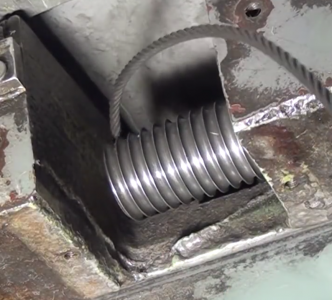- Joined
- Oct 16, 2019
- Messages
- 6,596
I may be forced to convert the table drive system my Parker Majestic from steel tapes to cable.
Edit: I am only considering this because I do not know if I can get replacement steel tapes
The steel tapes currently wind around a hub, maybe 3" in diameter. The hub is completely smooth.
I might just try a couple of wraps of coated cable around the existing hub and see if there's sufficient friction to grip the cable.
Alternatively, I'm considering making a new hub with grooves for a cable.
Something like what is shown in this photo, basically a very coarse screw.

My lathe can cut thread pitches from 4 TPI and up. If I grind a form tool to match the diameter of the cable I can cut the right shape groove. The part that stumps me is what pitch to cut.
I need someone to check my thinking...
A 3/16" cable is .1875" in diameter
4 TPI is going to cut grooves .25" apart.
5 TPI is going to cut grooves .20" apart
5.5 TPI is going to cut grooves .182" apart
So I think my choice is either 5 TPI which will leave a small flat between grooves or 5.5 TPI which won't leave a flat crest.
Edit: I am only considering this because I do not know if I can get replacement steel tapes
The steel tapes currently wind around a hub, maybe 3" in diameter. The hub is completely smooth.
I might just try a couple of wraps of coated cable around the existing hub and see if there's sufficient friction to grip the cable.
Alternatively, I'm considering making a new hub with grooves for a cable.
Something like what is shown in this photo, basically a very coarse screw.

My lathe can cut thread pitches from 4 TPI and up. If I grind a form tool to match the diameter of the cable I can cut the right shape groove. The part that stumps me is what pitch to cut.
I need someone to check my thinking...
A 3/16" cable is .1875" in diameter
4 TPI is going to cut grooves .25" apart.
5 TPI is going to cut grooves .20" apart
5.5 TPI is going to cut grooves .182" apart
So I think my choice is either 5 TPI which will leave a small flat between grooves or 5.5 TPI which won't leave a flat crest.
Last edited:


